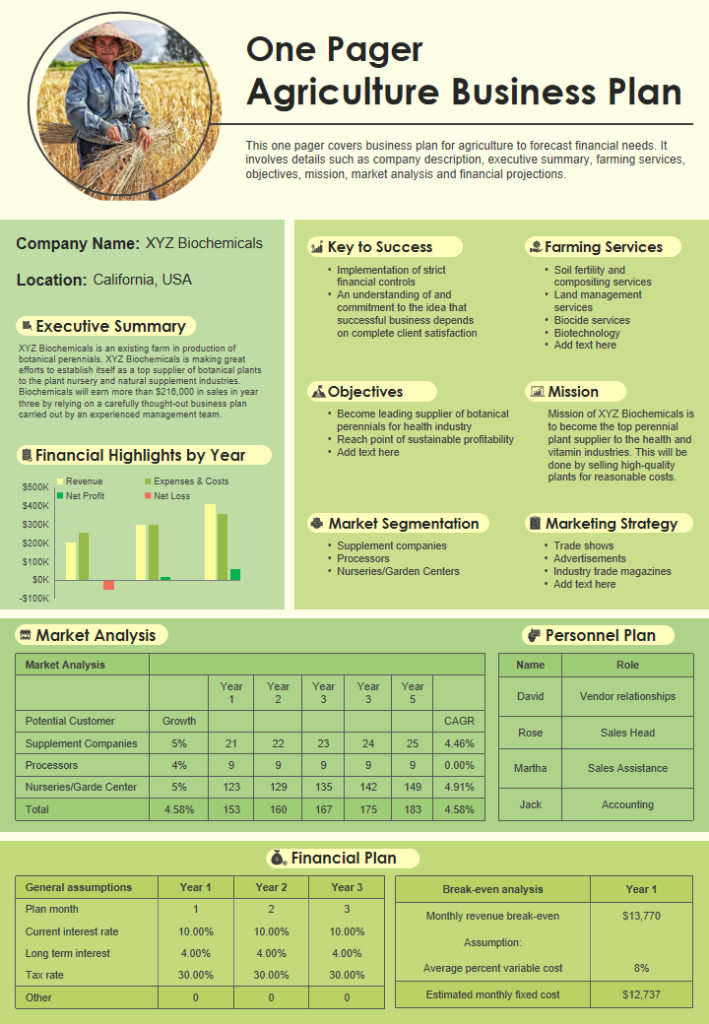Are you ready to turn your agricultural dreams into reality? Building a successful agribusiness starts with a solid plan.
But where do you begin? Whether you’re an aspiring farmer or an experienced grower looking to expand, a well-crafted agribusiness plan is your blueprint for success. Imagine having a clear roadmap that guides every step of your agricultural venture, helping you avoid costly mistakes and seize lucrative opportunities.
You’ll discover a practical template and real-world examples that simplify the process, making it easier than ever to outline your vision and goals. By the end, you’ll have the tools and confidence to create a plan that attracts investors and ensures long-term growth. Ready to dig in? Let’s get started on building your future in agriculture!

Market Analysis
Market analysis is crucial in building a successful agribusiness plan. It helps understand the industry landscape and potential customer base. By studying market trends, you can make informed decisions. This section will guide you through analyzing your target market.
Understanding Your Target Audience
Identify who will buy your products. Are they local farmers or urban consumers? Knowing your audience helps tailor your marketing strategies. Consider demographics like age, income, and location.
Analyzing Market Trends
Research current trends in the agribusiness sector. Are organic products gaining popularity? Is there a shift towards plant-based diets? Keeping up with trends ensures your business stays relevant.
Competitor Analysis
Study your competitors to find your unique selling point. What are they offering? How do their prices compare to yours? Understanding competitors helps you identify gaps in the market.
Identifying Market Gaps
Look for unmet needs in the market. Are consumers asking for more sustainable options? Identifying gaps can lead to new business opportunities. It helps differentiate your products from others.
Evaluating Market Size And Growth
Determine the size of your target market. Is it large enough to sustain your business? Look at growth trends to predict future demand. This helps plan for long-term success.

Financial Planning
Crafting a robust agribusiness plan involves understanding financial planning essentials. Templates and examples help guide effective strategy formation, ensuring sustainable growth. Clear financial plans boost confidence and decision-making in agribusiness ventures.
Creating a robust financial plan is essential for any successful agribusiness. It’s the backbone that supports your business goals and helps you make informed decisions. Without a clear financial plan, even the best agricultural ideas can struggle to thrive. ###Understanding Your Costs
Every agribusiness plan should start with a clear understanding of costs. Ask yourself: What are the initial expenses to kickstart your venture? Think about seeds, equipment, labor, and land. Break them down into fixed and variable costs to avoid surprises. ###Revenue Projections
Projecting revenue helps you anticipate your business’s financial future. Consider the types of crops or livestock you’ll manage and their market demand. Will seasonal changes affect your income stream? Use historical data and market trends to make realistic projections. ###Cash Flow Management
Effective cash flow management ensures your business can withstand tough times. Keep track of all cash inflows and outflows. A personal experience: I once underestimated the cash flow needs during a drought season, which taught me the importance of having reserves. ###Profit And Loss Statements
A profit and loss statement offers a snapshot of your business’s financial health. It’s more than just numbers—it shows where you’re making money and where you’re losing it. Regular reviews can help you spot trends and adjust your strategy accordingly. ###Funding And Investment Options
Consider the best funding options for your agribusiness. Are you looking at loans, grants, or investor funding? Each option has its pros and cons. For example, while loans can provide quick capital, they also come with interest obligations. ### Agriculture is fraught with risks, from natural disasters to market volatility. A solid financial plan includes strategies for risk management. Have you considered insurance options to protect your investments? Preparing for the unexpected is key to long-term success. ###Monitoring And Adjusting Your Plan
Your financial plan isn’t static; it should evolve with your business. Regularly review and adjust your financial strategies. Are your initial projections meeting reality? If not, what changes can you make to get back on track? Engaging with these questions can keep your agribusiness thriving. Incorporating these financial planning elements can make a significant difference in your agribusiness’s sustainability and growth. What steps will you take today to ensure a prosperous future for your venture?Operational Strategy
Crafting an agribusiness plan involves setting clear operational strategies. This template guides in defining goals, resources, and processes. Practical examples provide insights for effective implementation.
Creating an effective operational strategy is crucial for your agribusiness plan. It’s the blueprint for how your business will function daily. This strategy outlines your processes, resources, and logistics—ensuring everything runs smoothly. Think of it as the engine that drives your business forward. Without a solid operational strategy, your agribusiness might stall.Understanding Your Resources
Knowing what resources you have is the first step. Do you have enough land, equipment, and labor? These elements are the backbone of your operations. Imagine running a farm without enough tractors or skilled workers. It’s chaos. Assess your resources thoroughly. Use a simple table to list them—this helps you see gaps or excesses.| Resource | Quantity |
|---|---|
| Land | 50 acres |
| Tractors | 3 |
| Labor | 5 workers |
Streamlining Processes
How do you make sure every task is done efficiently? Streamlining processes is about cutting out unnecessary steps. You want to save time and money. Start by mapping out your daily operations. Which tasks take the longest? Which can be automated? Consider this: I once realized our harvesting process was lagging because of outdated equipment. Upgrading it reduced our harvest time by 20%. Simple tweaks can make a big difference. Ask yourself, what small change could drastically improve your operations?Logistics Management
Getting your products from farm to market involves logistics. This includes transportation, storage, and distribution. Poor logistics can lead to delays and losses. Create a checklist for your logistics needs. This might include securing reliable transport, ensuring storage facilities are adequate, and scheduling deliveries efficiently. Picture this: One weekend, our delivery truck broke down en route to the market. We learned the hard way about having a backup plan. Do you have contingency plans for logistical hiccups? If not, it’s time to develop them.Quality Control
Quality control ensures your products meet customer expectations. Poor quality can tarnish your reputation. How do you maintain high standards? Establish checkpoints throughout your production process. This could be regular inspections or testing samples. Consider feedback loops. Listen to your customers’ complaints and adjust accordingly. I once underestimated the importance of regular soil testing. Our crops suffered, and our customers noticed. Are you consistently delivering the best product possible? If not, what changes can you implement today? Your operational strategy is the heartbeat of your agribusiness. By focusing on resources, streamlining processes, managing logistics, and enforcing quality control, you set your business up for success. Have you reviewed your operational strategy lately? Are there areas you can refine for better efficiency?Risk Management
Crafting an agribusiness plan involves identifying potential risks and strategies to manage them effectively. Templates and examples aid in understanding the essential components, ensuring a comprehensive approach to risk management.
Risk management is an essential component of any agribusiness plan. The unpredictable nature of agriculture—ranging from weather-related challenges to fluctuating market prices—demands a strategic approach to mitigate potential risks. As an agribusiness owner, understanding and preparing for these uncertainties can be the difference between success and failure. Let’s explore how you can effectively manage risks in your agribusiness plan, using practical strategies and real-world examples. ###Understanding Potential Risks
Identifying risks is the first step in managing them. Think about the different aspects of your business that might be vulnerable. Are there external factors like climate change, pests, or diseases that could impact your crops? Consider internal risks such as equipment failure or labor shortages. Make a list and prioritize them based on their potential impact on your business. ###Developing A Risk Management Strategy
Once you’ve identified the risks, create a plan to address them. This might involve investing in insurance or diversifying your crop portfolio to spread risk. You might recall a time when unexpected frost damaged your crops. How did you respond? Use lessons from past experiences to shape your strategy. ###Implementing Preventative Measures
Preventative measures can save you from significant losses. Regular maintenance of machinery and equipment ensures they run smoothly and reduces the chance of breakdowns. Think about adopting sustainable farming practices to enhance soil health and reduce the risk of erosion. Such measures not only protect your business but also contribute to long-term sustainability. ###Monitoring And Reviewing Your Plan
A risk management plan should not be static. Regularly review and update your strategies to reflect changes in your business environment. Consider setting up a system to monitor key risk indicators. Ask yourself, are there new threats emerging? Are your current strategies effective? ###Learning From Others
Sometimes, the best insights come from observing others. Connect with fellow agribusiness owners and learn from their experiences. What strategies have they found effective? Sharing stories and tips can provide you with new ideas and perspectives on managing risks. ###Being Proactive
A proactive mindset is crucial. Anticipate challenges before they arise and prepare accordingly. Encourage your team to be vigilant and report potential issues early. By being proactive, you position your business to swiftly tackle challenges, maintaining stability and growth. ###Embracing Change
In the world of agribusiness, change is constant. Adaptability is key to surviving and thriving. Are there new technologies or practices you can adopt to minimize risks? Embrace change and encourage innovation within your team to stay ahead of potential threats. Risk management is not just a plan on paper; it’s a dynamic, evolving part of your business strategy. By understanding risks, developing strategies, and staying proactive, you can safeguard your agribusiness against uncertainties and pave the way for success. What steps will you take today to ensure your business is prepared for tomorrow’s challenges?
Conclusion
Creating an agribusiness plan is vital for success. It helps organize ideas and resources. Templates make this process easier. Examples provide clear guidance and inspiration. Start with a solid plan. Understand your market and goals. Focus on your strengths. Address challenges early.
Keep your plan flexible. Adapt to changes in the industry. Review your plan regularly. Seek feedback from trusted sources. An effective plan leads to growth and sustainability. With effort and planning, your agribusiness can thrive. Use these tools wisely. Your future in agriculture awaits!



